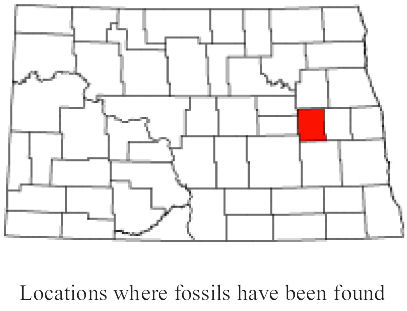

Mosasaurs were truly some of the most fascinating beasts ever to roam the ancient seas. They also played an early role in the science of paleontology. Many people who are interested in paleontology know the story of the discovery the "Muese River Lizard" that was examined by the famous 18th Century French naturalist, Cuvier, and eventually named Mosasaurus. Recently, the remains of a another mosasaur were discovered in North Dakota. Although a scientific description regarding the find has not been published yet, many interesting facts are coming to light about the discovery.

In the fall of 1995, Dennis Halvorson and Mike Hanson were exploring the outcrops of the Pierre Shale near Cooperstown, North Dakota, when they came upon an eight centimeter long section of a jaw. They immediately recognized that it belonged to a mosasaur, and called in North Dakota State Paleontologist John Hoganson and state fossil preparator Johnathan Campbell for assistance. Hoganson and Campbell expected to only stay for a few hours, but found themselves on the site for four days, and eventually excavating a nearly complete mosasaur skeleton.
The harsh winter conditions common in North Dakota stopped field work in late 1995, but the dig was continued in July of 1996. With help from land owner Orville Tranby, the team completed the excavation in four weeks. By the time they had recovered the remains, Hoganson and Campbell realized that they had the most complete skeleton of a mosasaur ever found in North Dakota. After Hoganson examined the bones in his lab, he was able to determine that they belonged to a mosasaur genus called Plioplatecarpus.
Although the specimen does not have a species name yet (Hoganson and Campbell are not quite sure if it is a new species. Additional study is needed.), the specimen may provide new insights into the evolution of mosasaurs. At 25 feet long, it is 25% bigger than any Plioplatecarpus ever discovered.
Many sharks' teeth were also found in the matrix surrounding the bone. The teeth were identified as those of crow sharks (Squalicorax). Sharks often lose their teeth when feeding, which led the team to believe that sharks had scavenged the mosasaur carcass. Problem is, there were few bite marks on the bones. The sharks, however, were relatively small compared to the size of this mosasaur, and may have simply stripped the flesh from the bones.
Mosasaurs became extinct near the end of the Cretaceous period, along with the dinosaurs and many other forms of life. This find may also give insights into how these major extinctions occurred. In this case, the remains were associated with layers of bentonite, a form of altered volcanic ash. Could there have been a period of prolonged volcanic activity, as Dr. Dewey M. McLean suggested, that literally suffocated the mosasaurs with ash? In spite of the evidence of volcanic ash associated with this specimen, Campbell does not agree with the theory. He points out that the ash layers both preceded and proceeded the skeleton, which indicates to him that volcanoes had little effects on the extinction of mosasaurs.
The extinction puzzle is still unsolved. Leading mosasaur expert Dr. Gorden Bell admits he is still puzzled by the extinction, but states that "we have every indication that they were very diverse and well adapted to their environment and doing quite well until the end of the Cretaceous." Mike Everhart, an Adjunct Curator of Paleontology at the Sternberg Museum in Kansas, points to a major collapse of the marine ecosystem that destroyed the food chain as a possible cause of their extinction. But, despite the mystery, most experts do agree that the ash does not give any insights into the extinction of one of the most awesome animal groups to ever stalk the seas.
The new mosasaur, which is still unnamed, is currently being prepared by Campbell. It should be finished and on display in the North Dakota Heritage Center by June 1999.
Because of Hoganson, Campbell, Halvorson, and Hanson, the world of paleontology has gained new insights into the fascinating prehistoric world of mosasaurs. But, don't think this is the only mosasaur story that will make the news. Scientists such as Bell, Hoganson, and Everhart are constantly reworking the current thinking on how these giant beasts lived. The late Cretaceous seas were dominated by these mosasaurs, and thanks to the exhaustive work of the North Dakota team, they are not quite so dead anymore, at least in our minds!
*Thanks to Mike Everhart for his thoughtful review of this article!*
**This article originally appeared in the Fall 1999 issue of the Maryland Geological Society Rostrum.**
The original html was found on this ReoCities site on January 20, 2012.